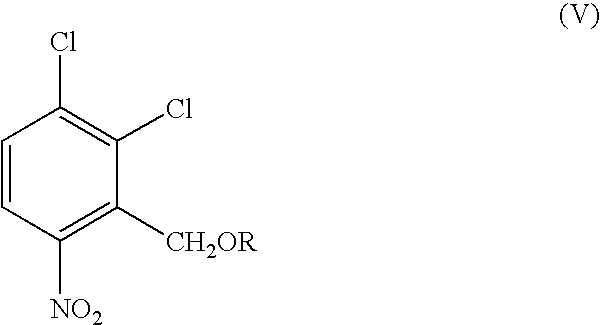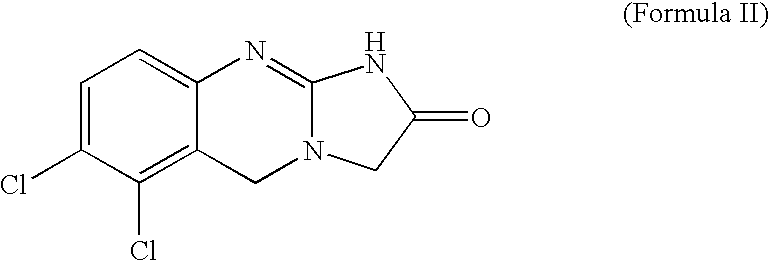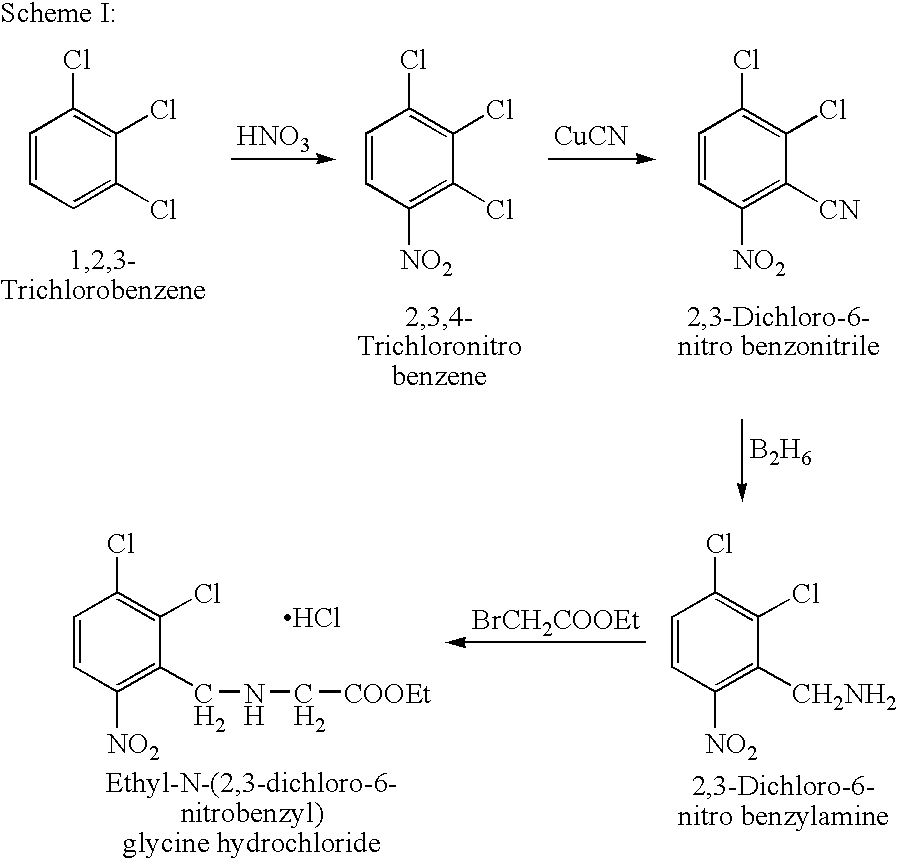Process for the preparation of ethyl-N-(2,3-dichloro-6-nitrobenzyl)glycine hydrochloride
a technology of ethyln(2,3-dichloro-6-nitrobenzyl) and glycine hydrochloride, which is applied in the preparation of sulfonic acid esters, drug compositions, extracellular fluid disorder, etc., can solve the problems of inability to control and industrially not feasible, inability to industrially viable, and exothermic reduction reaction, etc., to achieve the effect of reducing the platelet coun
- Summary
- Abstract
- Description
- Claims
- Application Information
AI Technical Summary
Benefits of technology
Problems solved by technology
Method used
Image
Examples
example 1
Preparation of 2,3-dichloro-6-nitro benzyl methane sulphonate, a Compound of Formula (V)
[0075]Methylene chloride (2000 ml) and sodium borohydride (120 g) were charged to a clean and dry flask and chilled to 0-5° C. Methanol (100 ml) was added slowly over a period of 20 minutes followed by 2,3-dichloro-6-nitro benzaldehyde solution (500 g in 2000 ml of methylene chloride) over a period of 2 hours maintaining the temperature at 0-5° C. and the contents were stirred at 0-5° C. for 1 hour. After completion of reaction, water (3000 ml) was added and stirred for 10 minutes. The organic layer was separated, dried over sodium sulphate and was filtered to get a clear filtrate.
[0076]To the clear filtrate triethylamine (460 ml), was slowly added over a period of 1 hour at 10-15° C., then methane sulphonyl chloride (325 ml) was added drop wise over a period of 2 hours maintaining temperature of 10-15° C. and the reaction mass was allowed to attain room temperature. Further the reaction mass was...
example 2
Preparation of ethyl-N-(2,3-dichloro-6-nitrobenzyl)glycine hydrochloride, a Compound of Formula (I)
[0077]2,3-dichloro-6-nitro benzyl methane sulphonate (Example 1) was dissolved in acetonitrile (2400 ml). To this reaction mass were charged anhydrous Potassium carbonate (480 g), dimethyl amino pyridine (480 mg) and glycine ethyl ester (240 g) at room temperature. The contents were stirred at 37-40° C. for 24 hours. After completion of reaction, the insolubles were filtered, washed with acetonitrile (120 ml). The clear filtrate was concentrated and stripped off using ethyl acetate (240 ml).
[0078]Further ethyl acetate (1200 ml) was added, chilled the contents to 5-10° C., adjusted the pH to 2.0 using IPA-HCl at 5-10° C. The contents were stirred at 5-10° C. for 1 hour. The solids were filtered, washed with chilled ethyl acetate (120 ml) and dried under vacuum at room temperature for 4 hours to give the title compound (595 g, 76% yield, 98.5% HPLC purity).
example 3
Preparation of Anagrelide, a Compound of Formula (II)
a) Preparation of Ethyl-5,6-dichloro-3,4-dihydro-2[1H]-imino quinazolin-3-acetate hydrobromide
[0079]A solution of stannous chloride dihydrate (1850 gms) in concentrated HCl (6.7 liters) was added slowly to a cooled solution of ethyl-N-(2,3-dichloro-6-nitrobenzyl)glycine hydrochloride (595 gms) in concentrated HCl (5.15 liters) maintaining temperature 15-20° C. over a period of 2 hours. The contents were heated slowly to 40-45° C. and stirred for 1 hour at 40-45° C. After completion of reaction, the contents were cooled to 15-20° C., maintained for 15 minutes and filtered.
[0080]The solids thus obtained were suspended in water (2.9 liters), adjusted the pH of the reaction mass to 8.0-9.0 using potassium carbonate solution (prepared by dissolving 376 gms of potassium carbonate in 4.25 liters of water) at 0-5° C., extracted into toluene (3.0 liters×3), dried over sodium sulphate and clarified.
[0081]To the clear toluene layer, added Cy...
PUM
| Property | Measurement | Unit |
|---|---|---|
| temperature | aaaaa | aaaaa |
| reaction temperature | aaaaa | aaaaa |
| temperature | aaaaa | aaaaa |
Abstract
Description
Claims
Application Information
 Login to View More
Login to View More - R&D
- Intellectual Property
- Life Sciences
- Materials
- Tech Scout
- Unparalleled Data Quality
- Higher Quality Content
- 60% Fewer Hallucinations
Browse by: Latest US Patents, China's latest patents, Technical Efficacy Thesaurus, Application Domain, Technology Topic, Popular Technical Reports.
© 2025 PatSnap. All rights reserved.Legal|Privacy policy|Modern Slavery Act Transparency Statement|Sitemap|About US| Contact US: help@patsnap.com



